Vishnu TV
Graph Neural Networks for Leveraging Industrial Equipment Structure: An application to Remaining Useful Life Estimation
Jun 30, 2020



Abstract:Automated equipment health monitoring from streaming multisensor time-series data can be used to enable condition-based maintenance, avoid sudden catastrophic failures, and ensure high operational availability. We note that most complex machinery has a well-documented and readily accessible underlying structure capturing the inter-dependencies between sub-systems or modules. Deep learning models such as those based on recurrent neural networks (RNNs) or convolutional neural networks (CNNs) fail to explicitly leverage this potentially rich source of domain-knowledge into the learning procedure. In this work, we propose to capture the structure of a complex equipment in the form of a graph, and use graph neural networks (GNNs) to model multi-sensor time-series data. Using remaining useful life estimation as an application task, we evaluate the advantage of incorporating the graph structure via GNNs on the publicly available turbofan engine benchmark dataset. We observe that the proposed GNN-based RUL estimation model compares favorably to several strong baselines from literature such as those based on RNNs and CNNs. Additionally, we observe that the learned network is able to focus on the module (node) with impending failure through a simple attention mechanism, potentially paving the way for actionable diagnosis.
Meta-Learning for Black-box Optimization
Jul 16, 2019



Abstract:Recently, neural networks trained as optimizers under the "learning to learn" or meta-learning framework have been shown to be effective for a broad range of optimization tasks including derivative-free black-box function optimization. Recurrent neural networks (RNNs) trained to optimize a diverse set of synthetic non-convex differentiable functions via gradient descent have been effective at optimizing derivative-free black-box functions. In this work, we propose RNN-Opt: an approach for learning RNN-based optimizers for optimizing real-parameter single-objective continuous functions under limited budget constraints. Existing approaches utilize an observed improvement based meta-learning loss function for training such models. We propose training RNN-Opt by using synthetic non-convex functions with known (approximate) optimal values by directly using discounted regret as our meta-learning loss function. We hypothesize that a regret-based loss function mimics typical testing scenarios, and would therefore lead to better optimizers compared to optimizers trained only to propose queries that improve over previous queries. Further, RNN-Opt incorporates simple yet effective enhancements during training and inference procedures to deal with the following practical challenges: i) Unknown range of possible values for the black-box function to be optimized, and ii) Practical and domain-knowledge based constraints on the input parameters. We demonstrate the efficacy of RNN-Opt in comparison to existing methods on several synthetic as well as standard benchmark black-box functions along with an anonymized industrial constrained optimization problem.
Data-driven Prognostics with Predictive Uncertainty Estimation using Ensemble of Deep Ordinal Regression Models
Apr 02, 2019
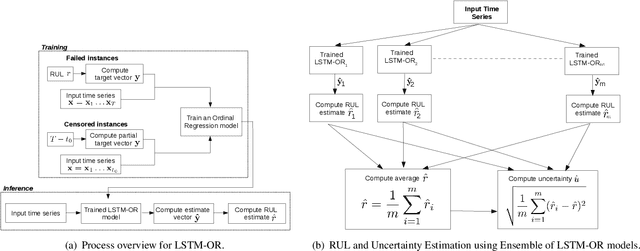
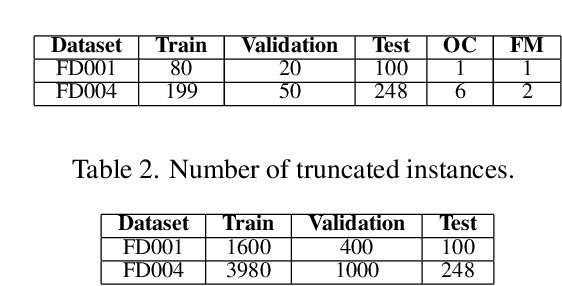
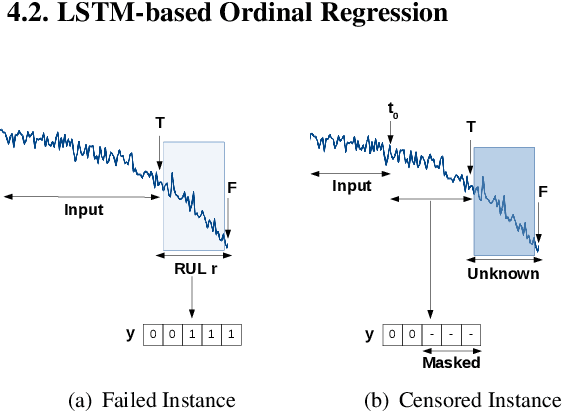
Abstract:Prognostics or Remaining Useful Life (RUL) Estimation from multi-sensor time series data is useful to enable condition-based maintenance and ensure high operational availability of equipment. We propose a novel deep learning based approach for Prognostics with Uncertainty Quantification that is useful in scenarios where: (i) access to labeled failure data is scarce due to rarity of failures (ii) future operational conditions are unobserved and (iii) inherent noise is present in the sensor readings. All three scenarios mentioned are unavoidable sources of uncertainty in the RUL estimation process often resulting in unreliable RUL estimates. To address (i), we formulate RUL estimation as an Ordinal Regression (OR) problem, and propose LSTM-OR: deep Long Short Term Memory (LSTM) network based approach to learn the OR function. We show that LSTM-OR naturally allows for incorporation of censored operational instances in training along with the failed instances, leading to more robust learning. To address (ii), we propose a simple yet effective approach to quantify predictive uncertainty in the RUL estimation models by training an ensemble of LSTM-OR models. Through empirical evaluation on C-MAPSS turbofan engine benchmark datasets, we demonstrate that LSTM-OR is significantly better than the commonly used deep metric regression based approaches for RUL estimation, especially when failed training instances are scarce. Further, our uncertainty quantification approach yields high quality predictive uncertainty estimates while also leading to improved RUL estimates compared to single best LSTM-OR models.
Predicting Remaining Useful Life using Time Series Embeddings based on Recurrent Neural Networks
Oct 06, 2017



Abstract:We consider the problem of estimating the remaining useful life (RUL) of a system or a machine from sensor data. Many approaches for RUL estimation based on sensor data make assumptions about how machines degrade. Additionally, sensor data from machines is noisy and often suffers from missing values in many practical settings. We propose Embed-RUL: a novel approach for RUL estimation from sensor data that does not rely on any degradation-trend assumptions, is robust to noise, and handles missing values. Embed-RUL utilizes a sequence-to-sequence model based on Recurrent Neural Networks (RNNs) to generate embeddings for multivariate time series subsequences. The embeddings for normal and degraded machines tend to be different, and are therefore found to be useful for RUL estimation. We show that the embeddings capture the overall pattern in the time series while filtering out the noise, so that the embeddings of two machines with similar operational behavior are close to each other, even when their sensor readings have significant and varying levels of noise content. We perform experiments on publicly available turbofan engine dataset and a proprietary real-world dataset, and demonstrate that Embed-RUL outperforms the previously reported state-of-the-art on several metrics.
TimeNet: Pre-trained deep recurrent neural network for time series classification
Jun 23, 2017



Abstract:Inspired by the tremendous success of deep Convolutional Neural Networks as generic feature extractors for images, we propose TimeNet: a deep recurrent neural network (RNN) trained on diverse time series in an unsupervised manner using sequence to sequence (seq2seq) models to extract features from time series. Rather than relying on data from the problem domain, TimeNet attempts to generalize time series representation across domains by ingesting time series from several domains simultaneously. Once trained, TimeNet can be used as a generic off-the-shelf feature extractor for time series. The representations or embeddings given by a pre-trained TimeNet are found to be useful for time series classification (TSC). For several publicly available datasets from UCR TSC Archive and an industrial telematics sensor data from vehicles, we observe that a classifier learned over the TimeNet embeddings yields significantly better performance compared to (i) a classifier learned over the embeddings given by a domain-specific RNN, as well as (ii) a nearest neighbor classifier based on Dynamic Time Warping.
Multi-Sensor Prognostics using an Unsupervised Health Index based on LSTM Encoder-Decoder
Aug 22, 2016
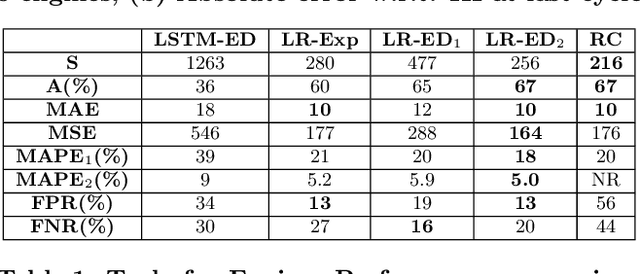
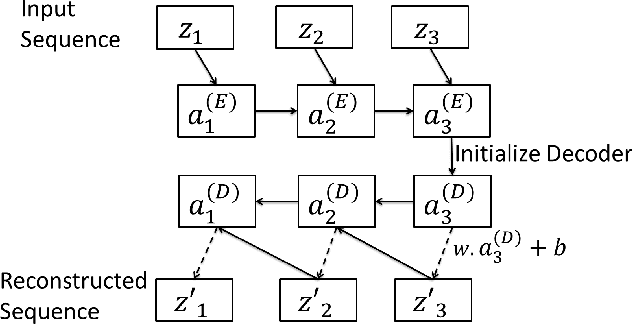

Abstract:Many approaches for estimation of Remaining Useful Life (RUL) of a machine, using its operational sensor data, make assumptions about how a system degrades or a fault evolves, e.g., exponential degradation. However, in many domains degradation may not follow a pattern. We propose a Long Short Term Memory based Encoder-Decoder (LSTM-ED) scheme to obtain an unsupervised health index (HI) for a system using multi-sensor time-series data. LSTM-ED is trained to reconstruct the time-series corresponding to healthy state of a system. The reconstruction error is used to compute HI which is then used for RUL estimation. We evaluate our approach on publicly available Turbofan Engine and Milling Machine datasets. We also present results on a real-world industry dataset from a pulverizer mill where we find significant correlation between LSTM-ED based HI and maintenance costs.
 Add to Chrome
Add to Chrome Add to Firefox
Add to Firefox Add to Edge
Add to Edge